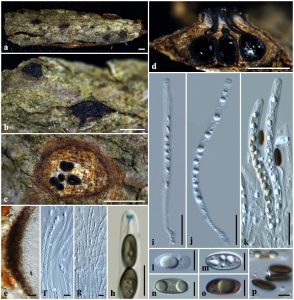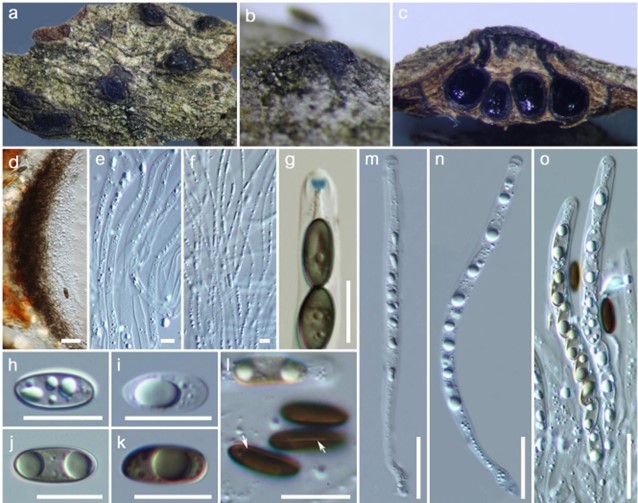Lopadostoma gastrinum (Fr.) Traverso, Fl. ital. crypt., Pars 1: Fungi. Pyrenomycetae. Xylariaceae, Valsaceae, Ceratostomataceae (Florence) 1(2): 169 (1906)
Index Fungorum number: IF 241129; Facesoffungi number: FoF 00071
Saprobic on dead land branch of Quercus sp. Sexual morph: Stromata 0.7–2.2 × 0.3–1.1 mm, effuse-pulvinate, immersed in the host and erumpent from bark, bluntly conical, surrounded by a narrow, black, carbonized encasement, appearing as a black line, ectostromatic disc visible as a clypeus and surrounded by reddish brown bark surface, convex, raised, dark grey, entostroma dark, usually black, multi-peritheciate. Ostiole papillate with inconspicuous ostiolar openings, necks white or pale brown. Perithecia 0.3–1.1 mm diam., clustered in valsoid groups, monodistichous, subglobose to flask-shaped, at the periphery inclined toward the center, tissue between perithecia loosely arranged, composed of white fungal tissue, mixed with light coloured bark cells, tissue beneath the perithecia compact, black, with short convergent ostiolar necks. Paraphyses of two types, 1.4–2.4 μm (x̅ = 1.9 μm, n = 20) wide, long, numerous, cylindrical, aseptate, smooth, guttulate and 1.9–3.9 μm (x̅ = 3 μm, n = 20) wide, septate, constricted at septum, rarely branched, smooth. Asci 82.8–116.5 × 5.1–7.2 μm (x̅ = 101.1 × 6.1 μm, n = 25), unitunicate, 8-spored, cylindrical, pedicellate, ellipsoidal-discoid, with a J+, apical ring. Ascospores 9.3–12.9 × 4.4–5.7 μm (x̅ = 11.2 × 4.8 μm, n = 30), L/W 2.3, uniseriate, at first hyaline, turning pale brown and dark brown at maturity, oblong to narrowly ellipsoid, symmetrical to slightly inequilateral, unicellular, smooth-walled, with a straight germ slit across the entire spore length present, when immature with 2 large guttules. Asexual morph: Undetermined.
Material examined – Italy, Province of Forlì-Cesena [FC], Monte Mirabello – Predappio, on dead fallen branch of Quercus sp. (Fagaceae), 12 April 2017, Erio Camporesi IT3269C (MFLU 17-0941; ibid. HKAS 102310).
GenBank numbers – ITS: MN337229, LSU: MN336233, RPB2: MN366245.
Known distribution (based on molecular data) – Austria, France, Greece, Poland, Spain, Italy (Jaklitsch et al. 2014, this study).
Known hosts (based on molecular data) – Acer campestre, Carpinus betulus, Prunus padus, Ulmus glabra, Ulmus minor (Jaklitsch et al. 2014), Quercus sp. (this study).
Notes – Jaklitsch et al. (2014) revised the genus with a neotype for Lopadostoma gastrinum. In the identification key provided by Jaklitsch et al. (2014), L. gastrinum on Ulmus and other hosts were emphasized, but not on Fagus or Quercus. However, in this study, we found L. gastrinum on a dead fallen branch of Quercus sp. from Italy. The type species described in Jaklitsch et al. (2014) is similar in morphology and phylogeny to the specimen described in this study. Size and shape of asci and ascospores of MFLU 17-0941 (asci 101.1 × 6.1 μm, ascospores 11.2 × 4.8 μm, L/W 2.3) overlap in the range of WU 32046 (neotype) (asci 88–110 × 6.5–8 μm, ascospores 10.5–12.8 × 4.5–5.5 μm, L/W 2–2.7). These morphological comparisons are more important for Lopadostoma species identification (Jaklitsch et al. 2014). Also, the BLASTn for ITS data of MFLU 17-0941 is 100% similar with L. gastrinum (WU 32046) and cluster with the same species in combined multigene analyses with high bootstrap support (Fig. 2). Thus, L. gastrinum (MFLU 17-0941) collected on Quercus sp. is herein reported as a new host record.

Fig. 1 – Lopadostoma gastrinum (MFLU 17-0941). a−c Stromata on the host. d Cross section of stroma. e Peridium. f, g Paraphyses. h J+, apical ring in Melzer’s reagent. i−k Asci. l−p Ascospores (p white arrow shows germ slit). Scale bars: a−d = 1000 μm, e, i−k = 20 μm, h = 10 μm, f, g, l−p = 5 μm

Figure 2 – Lopadostoma gastrinum (Material examined – ITALY, Province of Forlì-Cesena [FC], Monte Mirabello – Predappio, on dead fallen branch of Quercus sp. (Fagaceae), 12 April 2017, Erio Camporesi IT3269C, MFLU 17-0941; ibid. HKAS 102310). a, b Stromata on the host. c Cross section of stroma. d Peridium. e, f Paraphyses. g J+, apical ring in Melzer’s reagent. h-l Ascospores (l-white arrows show germ slit). m-o Asci. Scale bars: d, m-o = 20 μm, g-l = 10 μm, e, f = 5 μm.
